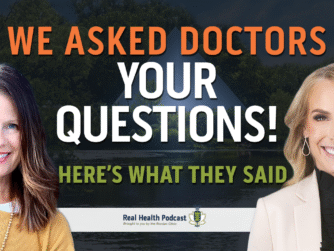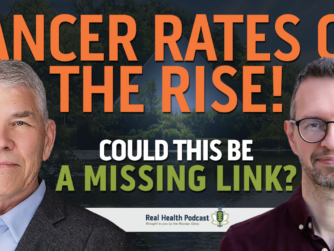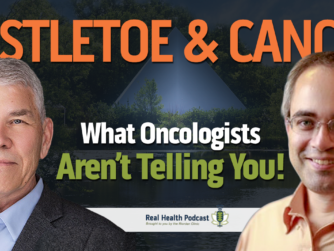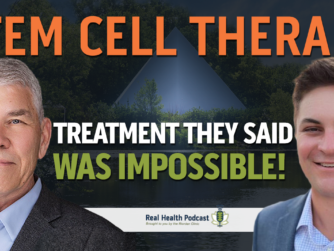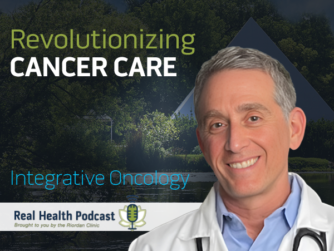Dr. Ron Hunninghake, MD, Chief Medical Officer, and Dr. Lucas Tims, ND, FABNO, continue their discussion about the terrain approach to integrative oncology in this episode of the Real Health Podcast. Today’s episode features two of the 10 terrains: inflammation and angiogenesis. Dr. Ron and Dr. Lucas explain how these two terrains can work in both good and harmful ways and what steps patients can take to help control them.
Thank You To This Episode’s Sponsor
Episode Links and Promotions
Metabolic Terrain Institute of Health
Eat to Beat Disease – Dr. William Li
RECNAC Research – Riordan Clinic
Episode Transcript
Disclaimer: The information contained on the Real Health Podcast and the resources mentioned are for educational purposes only. They are not intended as, and shall not be understood or construed as medical or health advice. The information contained on this podcast is not a substitute for medical or health advice from a professional who is aware of the facts and circumstances of your individual situation. Information provided by hosts and guests on the Real Health Podcast, or the use of any products or services mentioned, does not create a practitioner-patient relationship between you and any persons affiliated with this podcast.
Intro: This is the Real Health Podcast, brought to you by Riordan Clinic. Our mission is to bring you the latest information and top experts in functional and integrative medicine to help you make informed decisions on your path to real health.
Dr. Ron Hunninghake: Well, welcome once again, everyone. This is Dr. Ron Hunninghake, and we’re broadcasting the Real Health Podcast again today. And we’re fortunate to have Dr. Lucas Tims as our honored guest. Dr. Tims, thank you for being on with us to help us understand a little bit more about the metabolic approach to cancer.
Dr. Lucas Tims: Yeah. Thanks Dr. Ron. This has been a good ongoing conversation between you and I. And excited to get back into it and talk about another couple of key components of the terrain based approach that we take here.
Dr. Ron Hunninghake: Yep. Yeah. So this is really integral to integrative oncology where we’re trying to fill in the gap that some people have experienced in terms of, “Doctor, what can I do to take better care of myself and help get this cancer under control?” And so today we’ve talked about in the past epigenetics, metabolics, environment, and that was a really good recording. And now we’re going to shift into inflammation and angiogenesis. They’re the second group of terrain areas that a patient can begin to think about, a cancer patient, or even someone that’s got a family history or increased risk for cancer. These are all areas that people can become more aware and start to make changes in their lives that will help either reduce their risk or slow the growth or stop the growth of the cancering process. So tell us a little bit, how would inflammation in angiogenesis go together, Dr. Tims?
Dr. Lucas Tims: Well, they’re both drivers of not only cancer, but you could kind of say all chronic disease. They are inherent processes that happen in our body and can happen in a healthy way that helps to protect us and helps us to heal when we get injured and there’s acute inflammation. There’s such thing as good inflammation and good angiogenesis. The problem is that with cancer, unfortunately, when we talk about chronic inflammation and cancer angiogenesis, they kind of hijack those what would normally be healthy functions in our body and kind of use them to their advantage to grow and spread.
Dr. Ron Hunninghake: Sure. Yeah. If we cut ourselves, we want some inflammation to come into that cut to protect us from getting an infection there. We want new blood vessels to start growing in the direction of that wound in order to heal the wound. But cancer has been described as a non-healing wound where these processes actually, as you say, drive the cancering process and can make it worse. So what are some of the chronic causes of inflammation that might be affecting a cancer patient?
Dr. Lucas Tims: Well, inflammation is such a deep subject. We could do several podcasts just on inflammation alone.
Dr. Ron Hunninghake: Sure.
Dr. Lucas Tims: There was a book written not too long ago called Inflammation Nation talking about the U.S., Obviously, and basically our whole modern culture and culture in society, everything from what we eat to the chronic high levels of stress, our poor sleep habits, the environment that we’re exposing ourselves to, all these things really can drive inflammation, unfortunately. And a lot of medications too. We’re a heavily medicated society as well. And so a lot of medications also cause inflammation in other parts of the body. And so it’s a major linchpin in all chronic illnesses like we talked about. But in cancer, I see it as if you can’t control inflammation, you can’t control cancer.
Dr. Ron Hunninghake: How would a cancer patient or anyone know that they had chronic inflammation in their body? What would be some of the ways that they might experience this?
Dr. Lucas Tims: Yeah, well obviously there are some various constellations of symptoms. There could be joint pain. There could be gut problems or digestive problems, brain fog, fatigue, skin rashes, trouble breathing. It really depends on what systems are being affected by the inflammation, right? But it really can be… And a lot of times, interestingly enough, when patients go to their traditional doctor with these kind of various complaints, they oftentimes don’t know what to do with them.
Dr. Ron Hunninghake: Yeah, yeah.
Dr. Lucas Tims: Unless there’s a very kind of cut and dried diagnosis. So you’ve got arthritis in this joint or you’ve got colitis or whatever, and they label it, which is basically just saying, oh, you have inflammation of this part of your body. But their answer to chronic inflammation is it is kind of a bandaid approach. And it’s not really addressing, getting back to what you talked about a second ago with what’s actually driving the in inflammation, which is our diet and our lifestyle and our environment. Those issues aren’t really being addressed. And so patients, oftentimes these symptoms just get kind of bandaided and the actual driver of the inflammation is not being addressed.
Dr. Ron Hunninghake: Sometimes it’s not even known. For example, chronic infections in the body can be hidden. Chronic sinus infection, a dental infection, an abscess, or an infected tooth. Or autoimmune diseases that are causing leaky gut and causing bacteria from the gut to get into the body and trigger inflammatory responses, which can show up as autoimmune diseases. So these hidden things, what would be some lab things that we could do that might help a patient understand that they do have hidden inflammation or chronic inflammation?
Dr. Lucas Tims: Yeah. There’s a lot of great lab tests that we usually include in our initial panel, certainly with all of our cancer patients. But I would say you could probably run these on any patient with a chronic illness. A great one to start with, it’s kind of a general inflammation marker, is c-reactive protein. I particularly like to use the high sensitivity one versus the general cardio one. Sedimentation rate, which is a measure of kind of how thick and viscous the blood is and how long it takes to settle in the tube. Lactase dehydrogenase. Lactic acid is a byproduct of inflammation. And so this enzyme, LDH or lactase dehydrogenase, when there’s a lot of inflammation, it gets ramped up. Ferritin is another one, especially in cancer patients, which is usually looked at as a measurement of stored iron, but it actually can be an acute phase reactant and can mimic inflammation in the body, or at least reflect inflammation levels in the body. Reverse T3. I know that’s another one that you really like to watch.
Dr. Ron Hunninghake: Yeah, I do.
Dr. Lucas Tims: Measure of not only inflammation, but oxidative stress, which are very similar type issues. Vitamin D levels. When they’re low, if patients are supplementing correctly, some patients won’t be, but if they’re supplementing correctly and they’re not able to get their vitamin D levels up easily, that can be a sign of a lot of inflammation in the body. And then looking at doing some functional stool testing, functional gut testing. There’s lots of things that you can look at in the gut in terms of different enzymes and secretory IgA, things like that. That can look at more inflammation in the gut itself.
Dr. Ron Hunninghake: These are great examples, Dr. Tims. And it brings up a really good point that I think one of the fascinating discoveries in the metabolic approach to cancer, Dr. Nasha Winters, that she used three or four of these as actual markers as to whether or not the cancer is under control or is actually starting to progress and get worse. Which I know our cancer patients are always asking, am I better? Am I doing the right thing to control the cancer? And these could be really useful ways to track just exactly how well the therapies are working.
Dr. Lucas Tims: Yeah. I think especially when you’re coming at cancer from a terrain based approach, you’re oftentimes the traditional oncologists are focused on more the markers that are specific to the cancer itself, whereas we may be in addition to looking at that, we may also be looking at markers of how is the body and the body’s systems and the inflammation in the body and the terrain of the body actually working. And so we can track progress on those levels instead of just focusing on the cancer itself, because really you want both of those things to be moving in the right direction. Not only there’s a lot signals going down, but the body’s ability and the body health signals improving.
Advertisement: Today’s podcast is brought to you by Bio-Center Laboratories. The Bio-Center Laboratory provides state-of-the-art lab testing and diagnostic services for healthcare providers, laboratories, hospitals, and the general public. Lab tests available through Bio-Center include a comprehensive list of vitamins, minerals, fatty acids, amino acids, hormones, and pyrrolls. We also provide a variety of standardized tests for disease markers. These markers include cardiovascular disease, diabetes, thyroid dysfunction, hormone imbalance, and more. Visit biocenterlab.org to learn more.
Dr. Ron Hunninghake: Let’s shift our discussion a little bit to angiogenesis. Talk a little bit about that word, angiogenesis. And how does it play into the whole role of cancer?
Dr. Lucas Tims: Well, just from a basic definition standpoint, angio means blood. Genesis means new. So it’s the development of new blood vessels. And so your body’s always remodeling and forming new blood vessels. And that’s one of the amazing abilities of the body is to regenerate, form new blood flow, to certain areas like you talked about earlier, when you have a wound or an injury, new blood flow is needed sometimes. And so the body’s ability to adapt and evolve and form these new vessels can be very helpful. But when you have a tumor and it also has the ability to sort of hijack this angiogenesis process, that can be a bad thing because these tumors become like vampires. And they don’t draw the blood vessels in at a normal, healthy rate, like you would with an injury or someplace that’s trying to repair. They can’t get enough. There’s no stop sign for them. And it’s just pedal to the metal, as much blood flow as they can get, as many nutrients as they can rob from your system. There’s no stopping them.
Dr. Lucas Tims: And so what we found is that combating angiogenesis or antiangiogenesis is a very helpful tactic against choking off the blood supply to cancers and stopping them from growing. Because not only are they pulling blood and pulling nutrients and fuel sources in, but that also gives the cancer a pathway to spread. Because we have these circulating tumor cells that are shedding off of tumors, and they’re getting into those blood vessels and floating around and possibly metastasizing. And so combating angiogenesis is vital. And they do have drugs that do that on the traditional side, but they tend to come with a lot of side effects. And honestly, if you look at a lot of the research, Avastin is a very common drug that’s used for anti angiogenesis. The research is pretty underwhelming. Although it tends to get used a lot in a lot of different types of tumors, the actual overall survival improvement in patients with that drug is not very good. So it’s not really solving the whole problem. Again, it’s a little bit more of a bandaid approach. But we can do a lot through our diet and through certain supplements and herbs and nutrients and even lifestyle practices that can counteract angiogenesis as well.
Dr. Ron Hunninghake: Yeah. There was a famous book, Eat to Beat Disease, where he went, the author, went into great depths about the phytonutrients that are in a colorful plant-based diet, which is something that we recommend for cancer patients. All cancer patients should be really looking carefully at their diet. And a lot of people say, well, what is it about the plant-based diet that is beneficial? And so aren’t there just a number of phytonutrients that would help control angiogenesis?
Dr. Lucas Tims: Yeah. There are. And like you said, there’s been a lot written about this. I really like Dr. William Lee.
Dr. Ron Hunninghake: That’s the book.
Dr. Lucas Tims: He’s written a couple of books now, I think, about this and is all over social media and websites. And so you can find him pretty easily. But he’s really one of the thought leaders in this area. Basically, yeah. Like you said, the more colorful, the better. We’re looking at these compounds that are oftentimes referred to as polyphenols or various other phytonutrients, rich in things like berries and green leafy vegetables, and a lot of herbs, parsley and things like that. And so getting a wide variety of these, because they all kind of have different ways that they help, the more variety, the better. And that’s why you do want to eat, they say, eat the rainbow. That’s one of the reasons why is because you are taking in a lot of various types of these polyphenols and phytonutrients that can block this more disease based angiogenesis that you see with cancerous tumors.
Dr. Ron Hunninghake: And this kind of takes us back to some of the traditional remedies for cancer, the herbal remedies. It also, I’m thinking of turmeric. It’s anti-inflammatory as well as antiangiogenic. And so it’s interesting that a lot of these classic herbal interventions, nutritional interventions, actually are treating a number of the terrains that we’re trying to control in terms of helping cancer patients hold the line and stop the growth of the tumor. And so it’s fascinating that the ancient sciences are now being verified by modern research.
Dr. Lucas Tims: Absolutely. You know, another thing that counteracts staying with angiogenesis is exercise.
Dr. Ron Hunninghake: Ah.
Dr. Lucas Tims: And that kind of might seem more counterintuitive to some people because they might think, well, if you’re increasing circulation, wouldn’t that drive blood flow to the tumors as well? But the body’s very smart and the type of circulation you get from exercise actually counteracts the angiogenesis of a tumor versus the healthy blood flow and healthy angiogenesis that we want in the body and improves the immune response and the body’s ability to circulate in a healthy way. So this is another way that between not only the diet, but lifestyle interventions, we can counteract that. And I like you brought up curcumin. But one of the other things that covers a lot of the terrain components is IV vitamin C.
Dr. Ron Hunninghake: Ah, you took the words right out of my mouth. A lot of people don’t know that in the original RECNAC research, which Dr. Riordan did. The RECNAC is the word cancer spelled backwards. His goal was to reverse the trends of cancer using substances that were effective but non harmful to the body. And it’s so interesting that high doses of vitamin C would have an antiangiogenic effect. Except that it was proven very clearly in our research and it’s available on our website under our research topic. And this is just one of about seven different ways that IV vitamin C modifies the metabolic terrain of the cancer patient’s body.
Dr. Lucas Tims: Yeah. Another one of those just multifaceted, multitargeted tools that we have in our arsenal. Obviously why it’s a backbone of a lot of our protocols. But yeah, there’s so much that can be done. Getting back to just these two components we’re talking about today with inflammation and angiogenesis. IV vitamin C. The mistletoe has some benefits against angiogenesis and inflammation. Curcumin’s a great one. High dose melatonin. There’s so many ways that we can help people to take control of some of these things that can be driving the cancer in non-toxic ways, really. And this is what’s really being missed when you’re just taking a sort of standard of care approach.
Dr. Ron Hunninghake: Right. It’s back to the concept of cancer as the non-healing wound. Everything that we’re talking about today represents low toxicity of non-toxic modalities that help promote a wound healing process. And this can help to counterbalance the toxic effects of standard, whether it’s chemotherapy or radiation. So this can be a very complimentary way to approach cancer care. And so isn’t this really the essence of integrative oncology?
Dr. Lucas Tims: I think so. To me, to you, to all of us that work in this space, it all just makes a lot of sense. And when we talk to patients, they tend to pick it up very quickly too and say, well, “Gosh, why aren’t these big cancer centers and why doesn’t my traditional oncologist tell me about all this stuff?” And there’s a lot of reasons why. But to me, if you’re just focused on the cancer and you’re not doing anything to support the terrain of the body, the soil of the body, the body’s ability to heal itself, you’re missing so much. And I think that’s why we’ve been kind of stuck in neutral in terms of really making headway on treating cancer and reversing cancer and preventing cancer, in our country especially.
Dr. Ron Hunninghake: This really helps to empower cancer patients because very often when they get that “you’ve got cancer” diagnosis, it takes the wind out of people’s sails. They get very depressed. And what they need is empowerment and knowing that they can both attack the tumor and change the environment of their body, the terrain of their body in such a way that they have a much better chance of getting longer life and better outcomes.
Dr. Lucas Tims: A hundred percent.
Dr. Ron Hunninghake: Well, Dr. Tims, thank you so much. This has been an enlightening discussion on inflammation and angiogenesis. Integral parts of the 10 terrains of metabolic approach to cancer. So thank you. And next time we’ll be exploring a couple more of these terrains. So hopefully our guests will log in and learn more about how they can take better care of themselves and be more effective in their control of the cancer. So thank you so much.
Dr. Lucas Tims: Absolutely.Outro: Thank you for listening to the Real Health Podcast. If you enjoy this episode, be sure to subscribe and leave us a review. You can also find all of the episodes and show notes over at realhealthpodcast.org. Also, be sure to visit Riordenclinic.org, where you will find hundreds of videos and articles to help you create your own version of real health.


